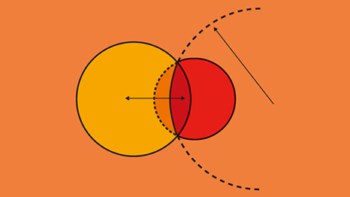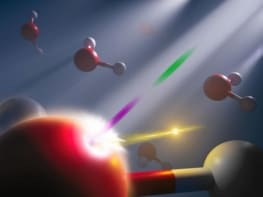
The warming effect of tiny “kicks” from photons colliding with a microscopic particle has been measured for the first time by physicists in Switzerland. These kicks put a fundamental limit on how particles can be cooled when confined in optical traps. Gaining a better understanding of this effect could lead to experiments in which a trapped particle is put into a well-defined quantum state. Such particles could then be used to study how such states evolve under the influence of gravity.
A particle can be confined in an optical trap by a potential-energy well created by the electromagnetic field of laser light. The confined particle undergoes harmonic motion with amplitude that depends on its energy. Individual atoms and ions can be addressed separately by a laser and their quantum states can be manipulated by photons. However, in most cases, the dominant heating mechanism for trapped macroscopic particles is thermal collisions with residual gas molecules that remain in the trap after it is evacuated.
Feedback cooling
In this latest experiment, a team led by Lukas Novotny of ETH Zurich confined silica nanoparticles of approximately 50 nm radius in an optical trap using an infrared laser, before sucking out almost all of the air to create an ultrahigh vacuum in the chamber. The researchers used a process called feedback cooling, in which the trapped particle’s position is monitored and the trap frequency modulated accordingly, to draw energy out of the particle’s motion and reduce its temperature to the microkelvin level.
At pressures greater than 10–9 atmospheres, they found that the lowest temperature they could reach was determined by pressure. Below this, however, the researchers found that the lowest achievable temperature approached a lower limit, irrespective of pressure. This, they say, means that at very low pressures, the dominant limitation on the cooling is electromagnetic noise present in the trap.
Recoil energy
To investigate further, the team switched off the feedback cooling at very low pressure, allowing the photons that trapped the particle to heat it freely. The gap between the energy states of the oscillating particle is orders of magnitude larger than the recoil energy from each individual photon collision, so most of the photons simply scattered off the particle elastically with no effect on its energy. Occasionally, however, photons managed to kick the nanoparticle into a higher oscillation state, gradually warming it up. The warming process was random, but, by repeating it many times and averaging their results, the researchers managed to generate smooth warming curves showing that, when trapped with a higher-power laser, the particle heated up faster.
“This really shows the difference compared to thermal heating [from collisions with gas molecules],” says Novotny. “Surely thermal heating would not depend on the laser power.” The researchers also showed that the rate of warming depended more strongly on particle volume than expected from thermal heating.
“High-hanging fruit”
The team is now looking at ways to make the particle even cooler, until its quantum nature becomes genuinely measurable. In such a situation, it would be interesting, says Novotny, to switch off the laser and track the particle’s behaviour. “We know where the particle should end up and when…any deviation from that would indicate that there must be additional terms that generate heating or decoherence or whatever.” The ultimate ambition, Novotny says, would be to look at the effect of gravity on the quantum state of the particle. “We have here a massive particle that feels gravity: if we release it in the trap, it falls. We could prepare the particle in a desired quantum state and measure how the quantum state evolves under the influence of the gravitational field. I think this is the true Holy Grail, but this is a very high-hanging fruit!”
Andrew Geraci of the University of Nevada in Reno, who was not involved in the research, says the effect has long been predicted. “Having seen a demonstration where the theory is in pretty good agreement with the experiment, one can predict that this will be a limitation at the level they’ve shown,” he explains. “One of the goals of their group, our group and many other groups in the field, is to try and cool the particle to its quantum ground state. One needs to overcome this sort of mechanism, and now it’s been measured and understood better, I think it will guide the community in what really has to be done to circumvent this limitation.”
The research is described in Physical Review Letters.



